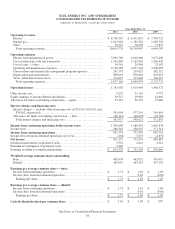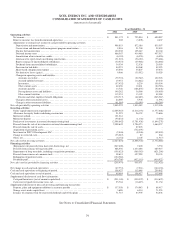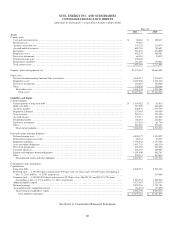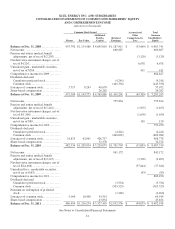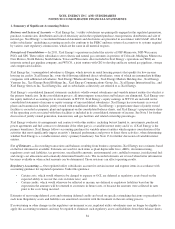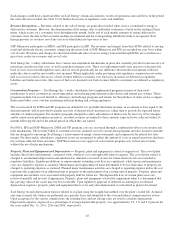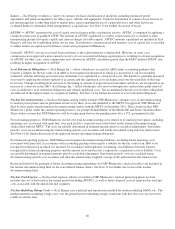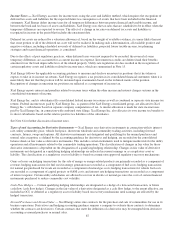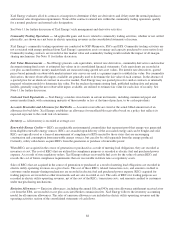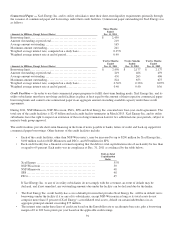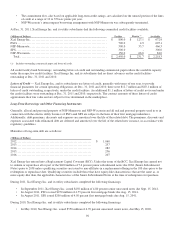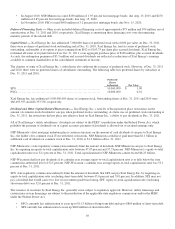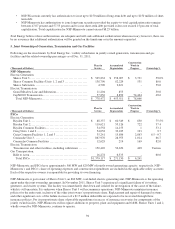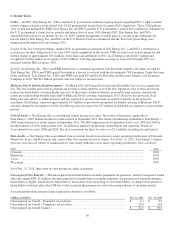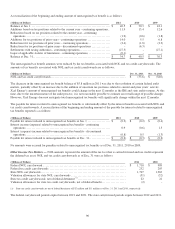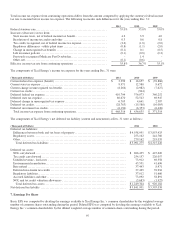Xcel Energy 2011 Annual Report Download - page 98
Download and view the complete annual report
Please find page 98 of the 2011 Xcel Energy annual report below. You can navigate through the pages in the report by either clicking on the pages listed below, or by using the keyword search tool below to find specific information within the annual report.88
Xcel Energy evaluates all of its contracts at inception to determine if they are derivatives and if they meet the normal purchases
and normal sales designation requirements. None of the contracts entered into within the commodity trading operations qualify
for a normal purchases and normal sales designation.
See Note 11 for further discussion of Xcel Energy’s risk management and derivative activities.
Commodity Trading Operations — All applicable gains and losses related to commodity trading activities, whether or not settled
physically, are shown on a net basis in electric operating revenues in the consolidated statements of income.
Xcel Energy’s commodity trading operations are conducted by NSP-Minnesota, PSCo and SPS. Commodity trading activities are
not associated with energy produced from Xcel Energy’s generation assets or energy and capacity purchased to serve native load.
Commodity trading contracts are recorded at fair market value and commodity trading results include the impact of all margin-
sharing mechanisms. See Note 11 for further discussion.
Fair Value Measurements — Xcel Energy presents cash equivalents, interest rate derivatives, commodity derivatives and nuclear
decommissioning fund assets at estimated fair values in its consolidated financial statements. Cash equivalents are recorded at
cost plus accrued interest; money market funds are measured using quoted net asset values. For interest rate derivatives, quoted
prices based primarily on observable market interest rate curves are used as a primary input to establish fair value. For commodity
derivatives, the most observable inputs available are generally used to determine the fair value of each contract. In the absence of
a quoted price for an identical contract in an active market, Xcel Energy may use quoted prices for similar contracts or internally
prepared valuation models to determine fair value. For the nuclear decommissioning fund, published trading data and pricing
models, generally using the most observable inputs available, are utilized to estimate fair value for each class of security. See
Note 11 for further discussion.
Cash and Cash Equivalents — Xcel Energy considers investments in certain instruments, including commercial paper and
money market funds, with a remaining maturity of three months or less at the time of purchase, to be cash equivalents.
Accounts Receivable and Allowance for Bad Debts — Accounts receivable are stated at the actual billed amount net of an
allowance for bad debts. Xcel Energy establishes an allowance for uncollectible receivables based on a policy that reflects its
expected exposure to the credit risk of customers.
Inventory — All inventory is recorded at average cost.
Renewable Energy Credits — RECs are marketable environmental commodities that represent proof that energy was generated
from eligible renewable energy sources. RECs are awarded upon delivery of the associated energy and can be bought and sold.
RECs are typically used as a form of measurement of compliance to RPS enacted by those states that are encouraging
construction and consumption from renewable energy sources, but can also be sold separately from the energy produced.
Currently, utility subsidiaries acquire RECs from the generation or purchase of renewable power.
When RECs are acquired in the course of generation or purchased as a result of meeting load obligations, they are recorded as
inventory at cost. The cost of RECs that are utilized for compliance purposes is recorded as electric fuel and purchased power
expense. As a result of state regulatory orders, Xcel Energy reduces recoverable fuel costs for the value of certain RECs and
records the cost of future compliance requirements that are recoverable in future rates as regulatory assets.
Sales of RECs that are acquired in the course of generation or purchased as a result of meeting load obligations are recorded in
electric utility operating revenues on a gross basis. The cost of these RECs, related transaction costs, and amounts credited to
customers under margin-sharing mechanisms are recorded in electric fuel and purchased power expense. RECs acquired for
trading purposes are recorded as other investments and are also recorded at cost. The sales of RECs for trading purposes are
recorded in electric utility operating revenues, net of the cost of the RECs, transaction costs, and amounts credited to customers
under margin-sharing mechanisms.
Emission Allowances — Emission allowances, including the annual SO2 and NOx emission allowance entitlement received at no
cost from the EPA, are recorded at cost plus associated broker commission fees. Xcel Energy follows the inventory accounting
model for all emission allowances. The sales of emission allowances are included in electric utility operating revenues and the
operating activities section of the consolidated statements of cash flows.


